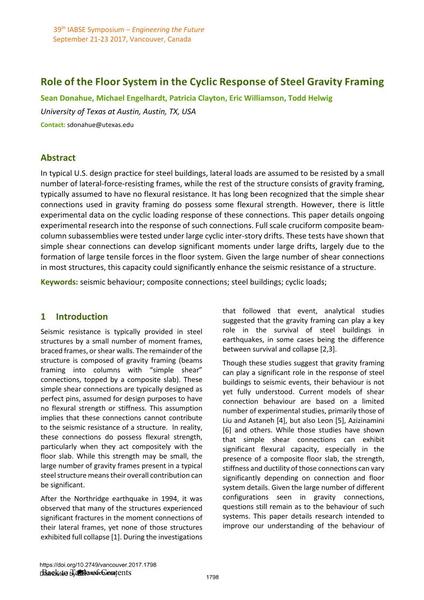Role of the Floor System in the Cyclic Response of Steel Gravity Framing

|
|
|||||||||||
Détails bibliographiques
| Auteur(s): |
Sean Donahue
(University of Texas at Austin, Austin, TX, USA)
Michael Engelhardt (University of Texas at Austin, Austin, TX, USA) Patricia Clayton (University of Texas at Austin, Austin, TX, USA) Eric Williamson (University of Texas at Austin, Austin, TX, USA) Todd Helwig (University of Texas at Austin, Austin, TX, USA) |
||||
|---|---|---|---|---|---|
| Médium: | papier de conférence | ||||
| Langue(s): | anglais | ||||
| Conférence: | IABSE Symposium: Engineering the Future, Vancouver, Canada, 21-23 September 2017 | ||||
| Publié dans: | IABSE Symposium Vancouver 2017 | ||||
|
|||||
| Page(s): | 1798-1804 | ||||
| Nombre total de pages (du PDF): | 7 | ||||
| Année: | 2017 | ||||
| DOI: | 10.2749/vancouver.2017.1798 | ||||
| Abstrait: |
In typical U.S. design practice for steel buildings, lateral loads are assumed to be resisted by a small number of lateral-force-resisting frames, while the rest of the structure consists of gravity framing, typically assumed to have no flexural resistance. It has long been recognized that the simple shear connections used in gravity framing do possess some flexural strength. However, there is little experimental data on the cyclic loading response of these connections. This paper details ongoing experimental research into the response of such connections. Full scale cruciform composite beam- column subassemblies were tested under large cyclic inter-story drifts. These tests have shown that simple shear connections can develop significant moments under large drifts, largely due to the formation of large tensile forces in the floor system. Given the large number of shear connections in most structures, this capacity could significantly enhance the seismic resistance of a structure. |
||||
